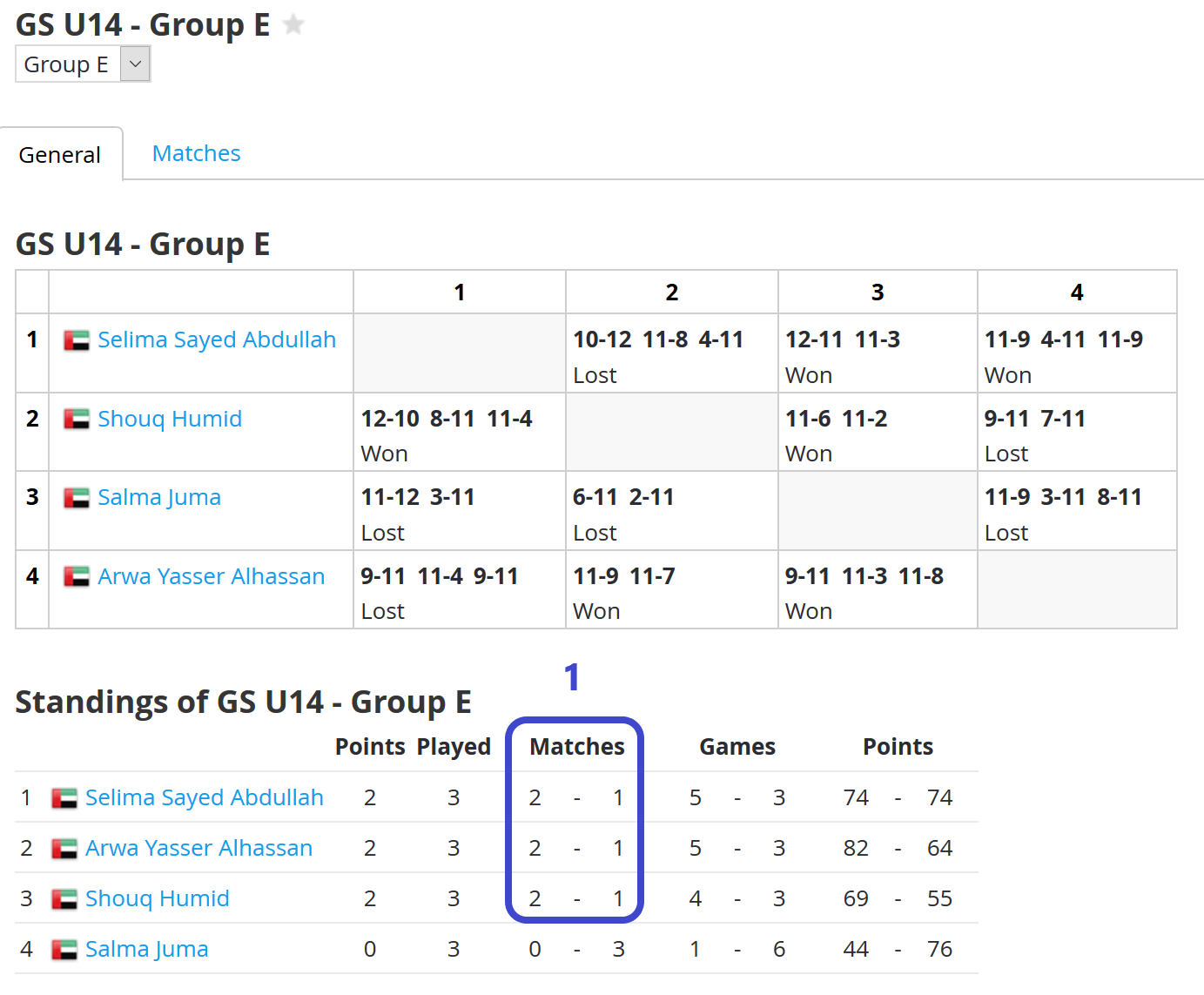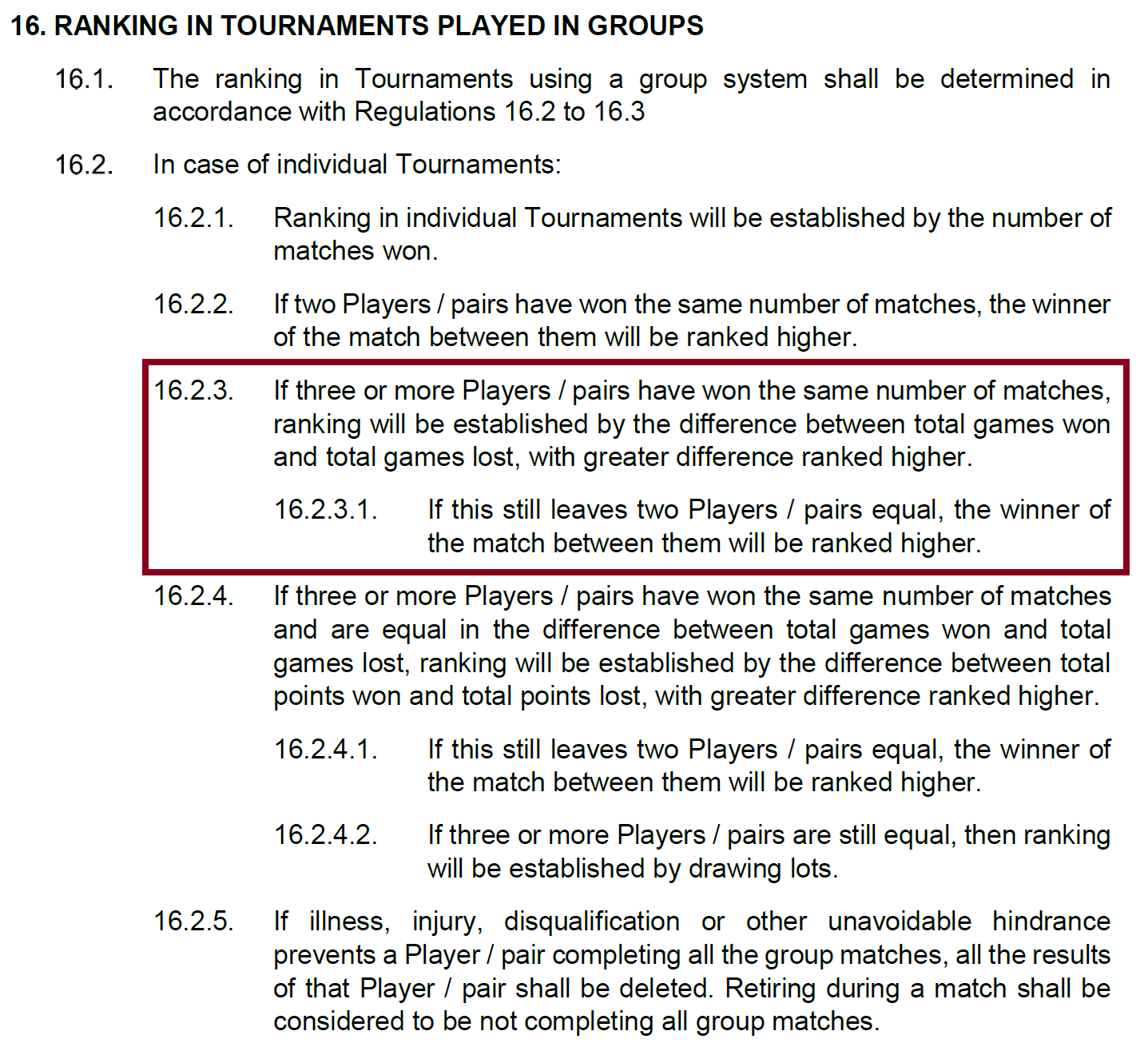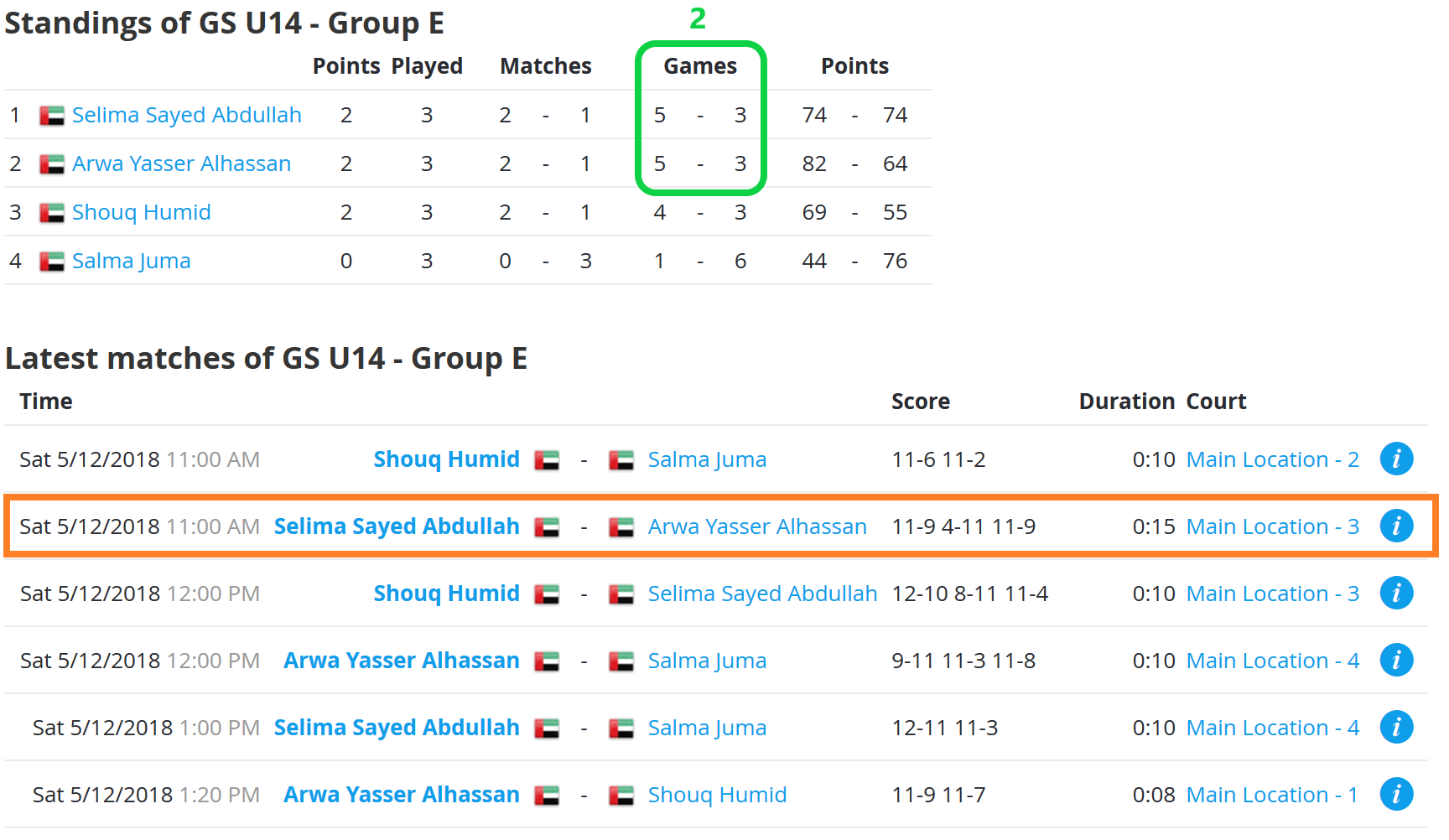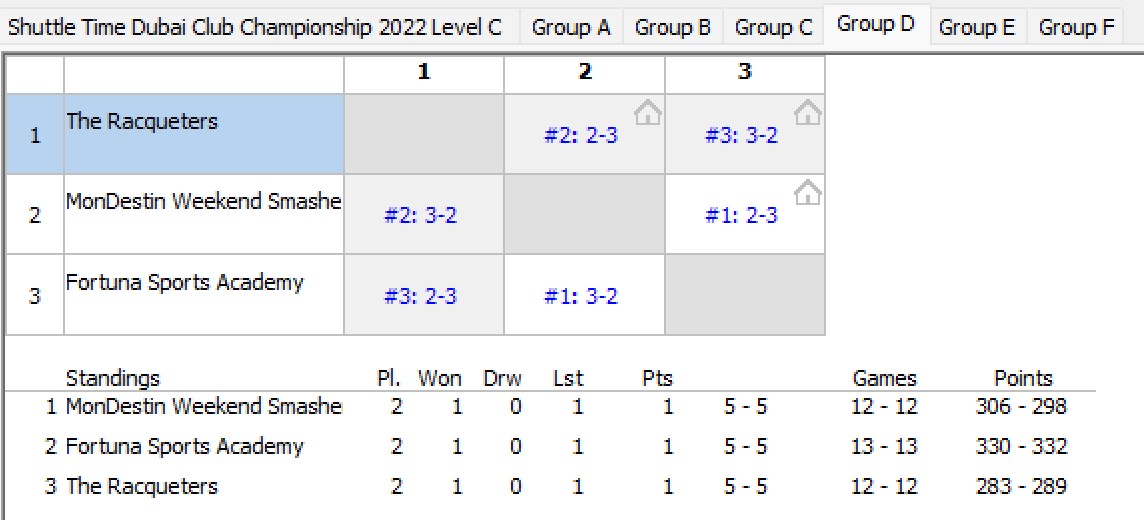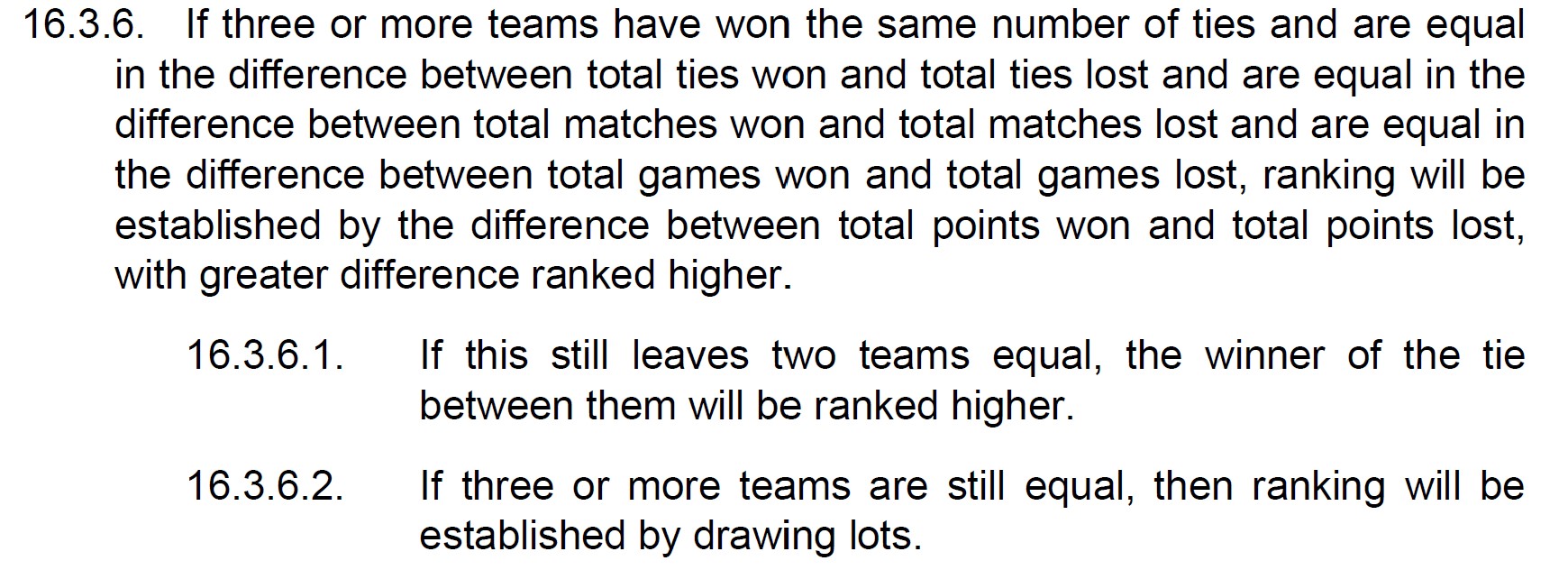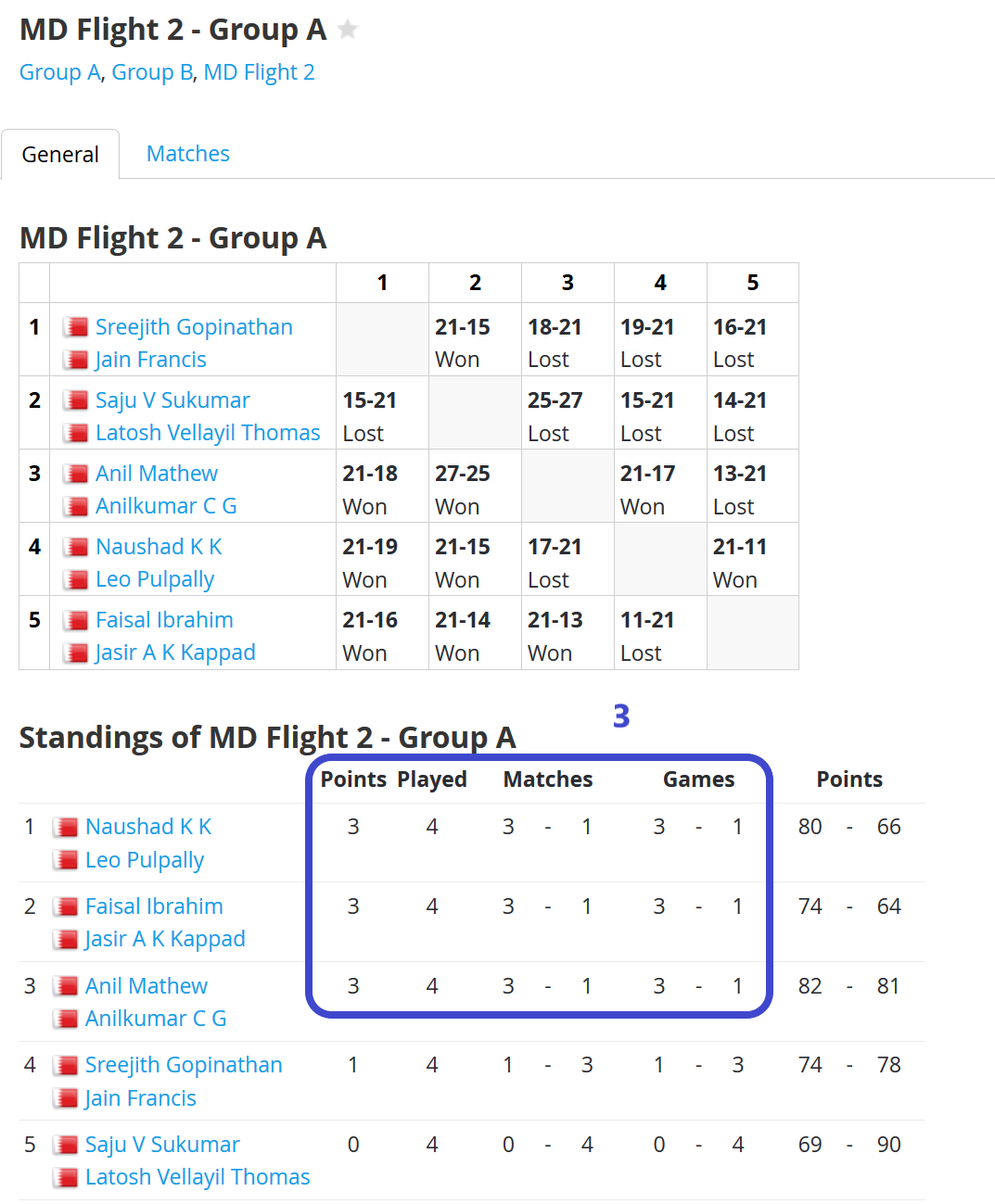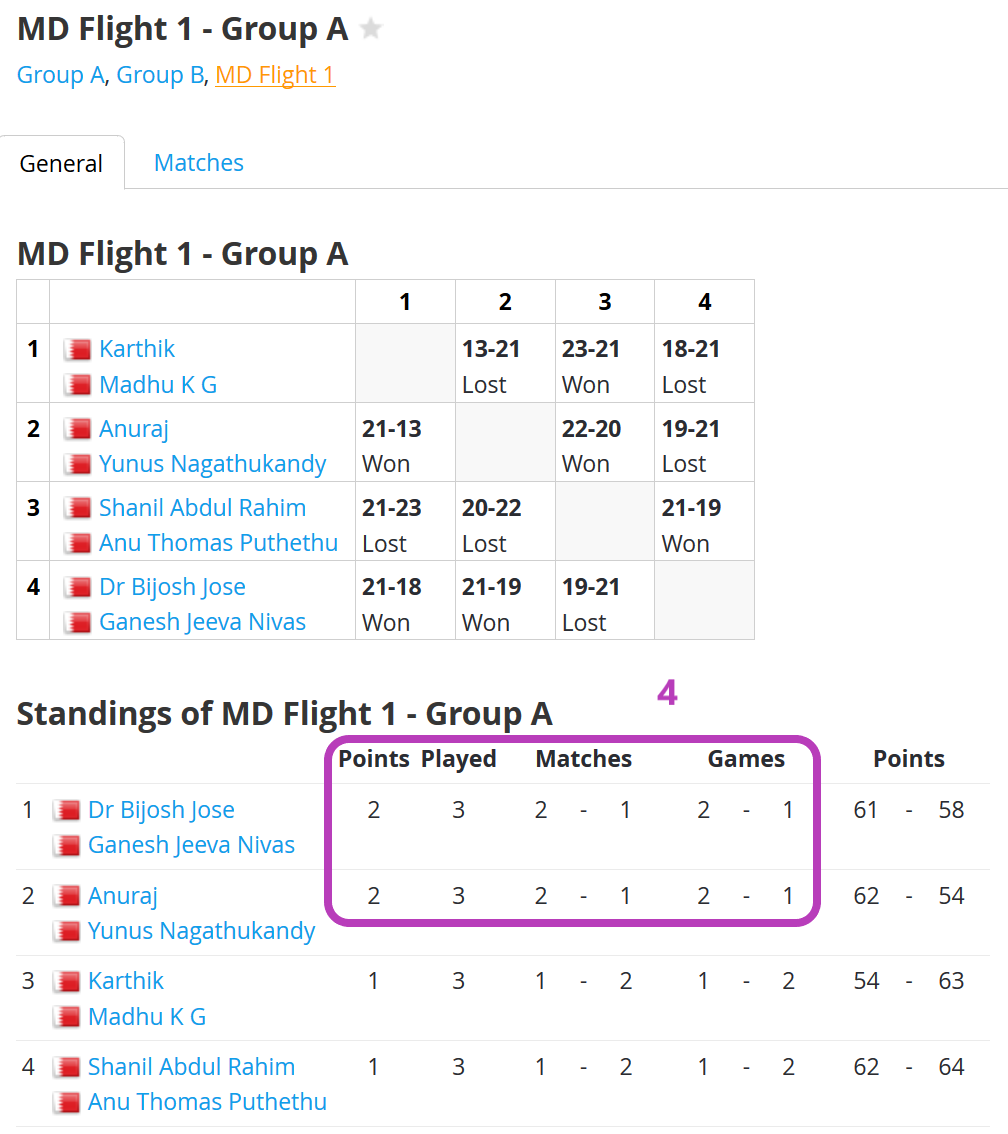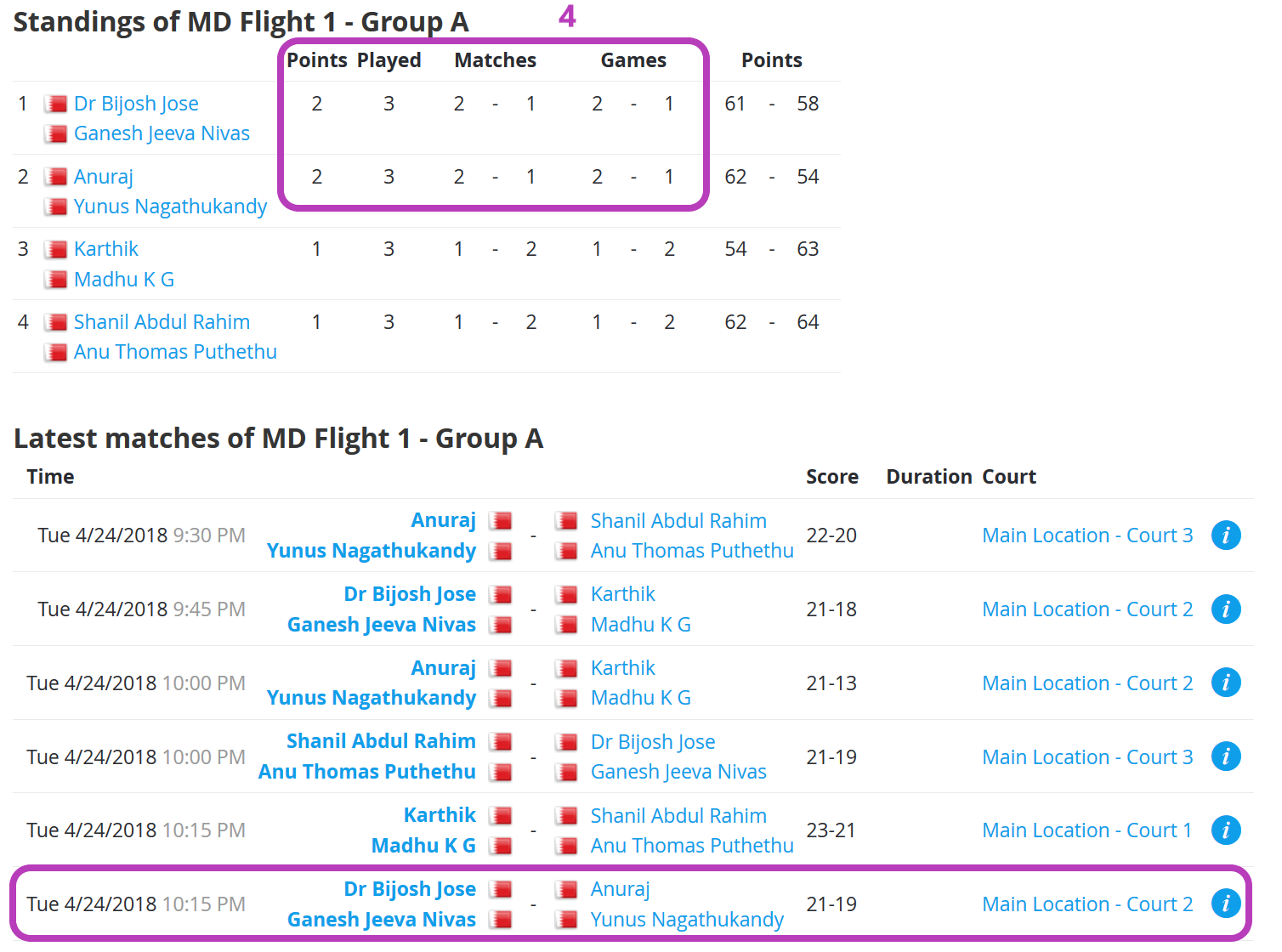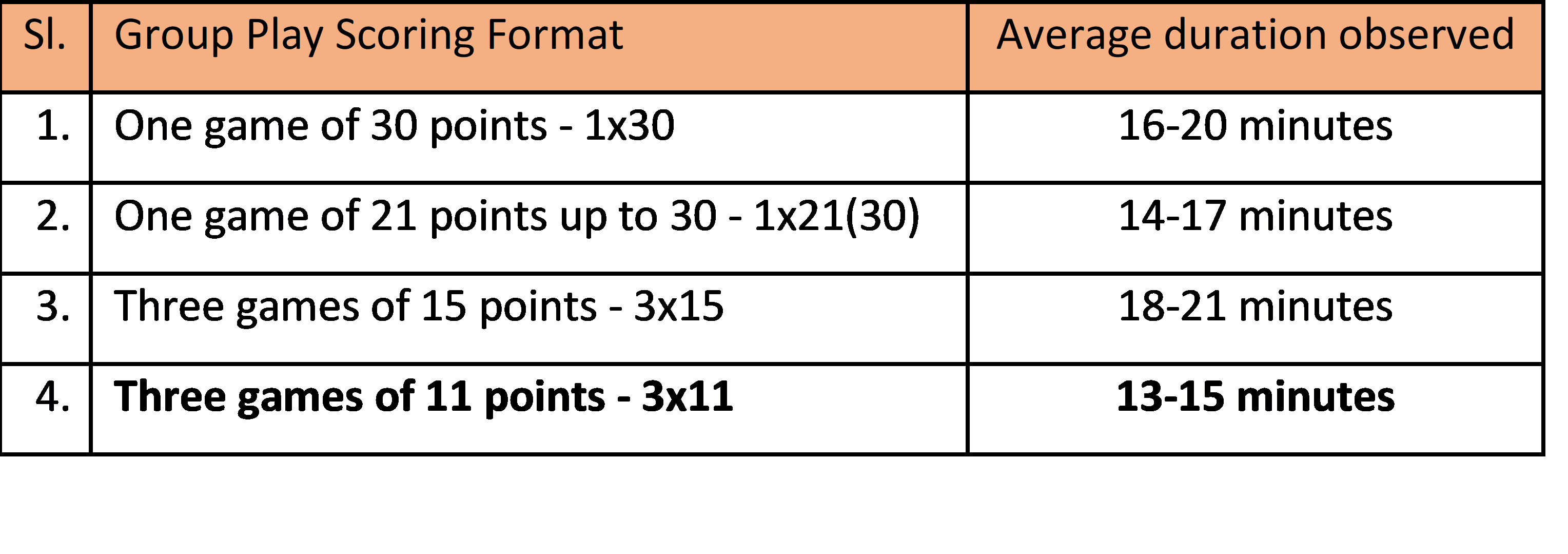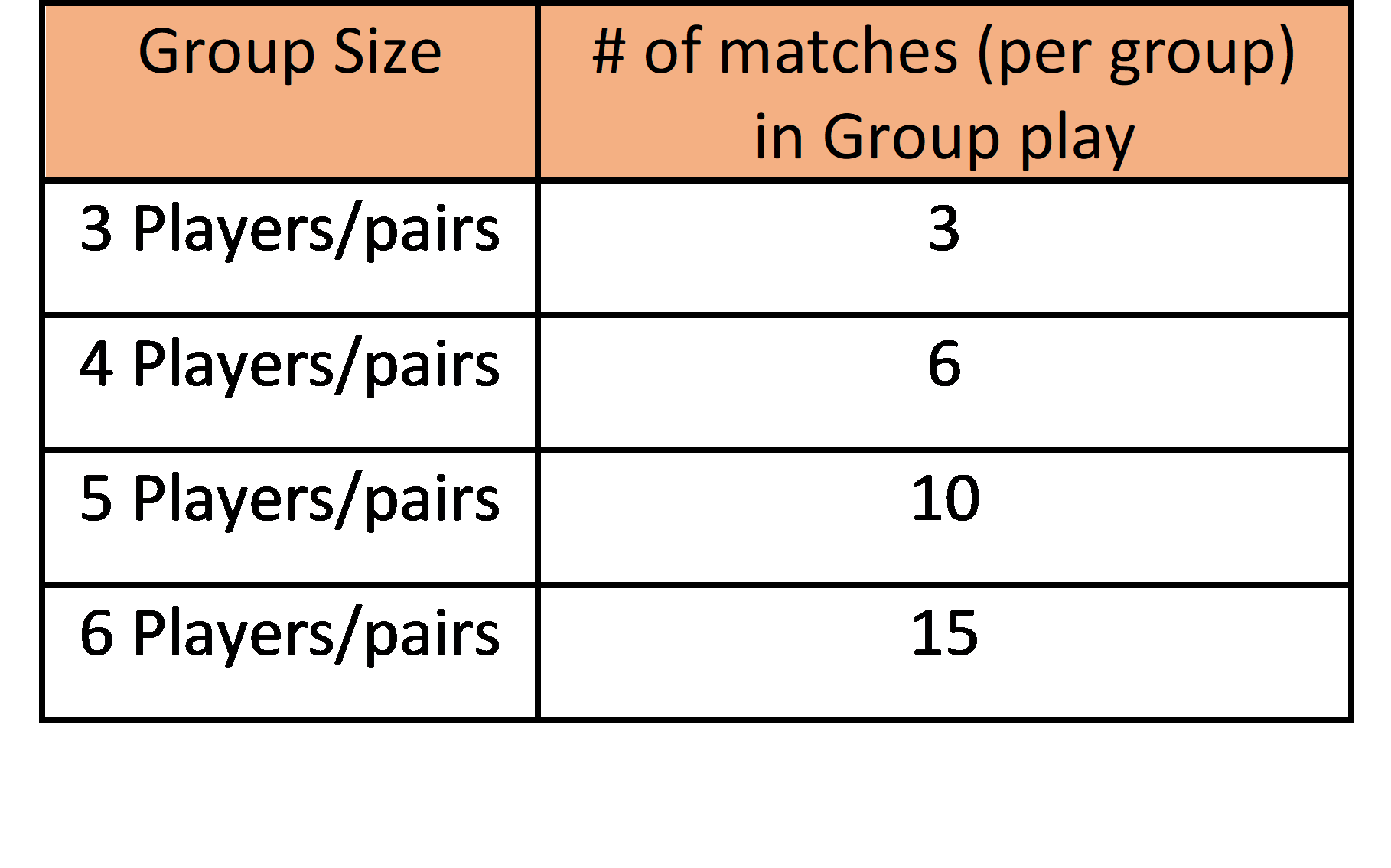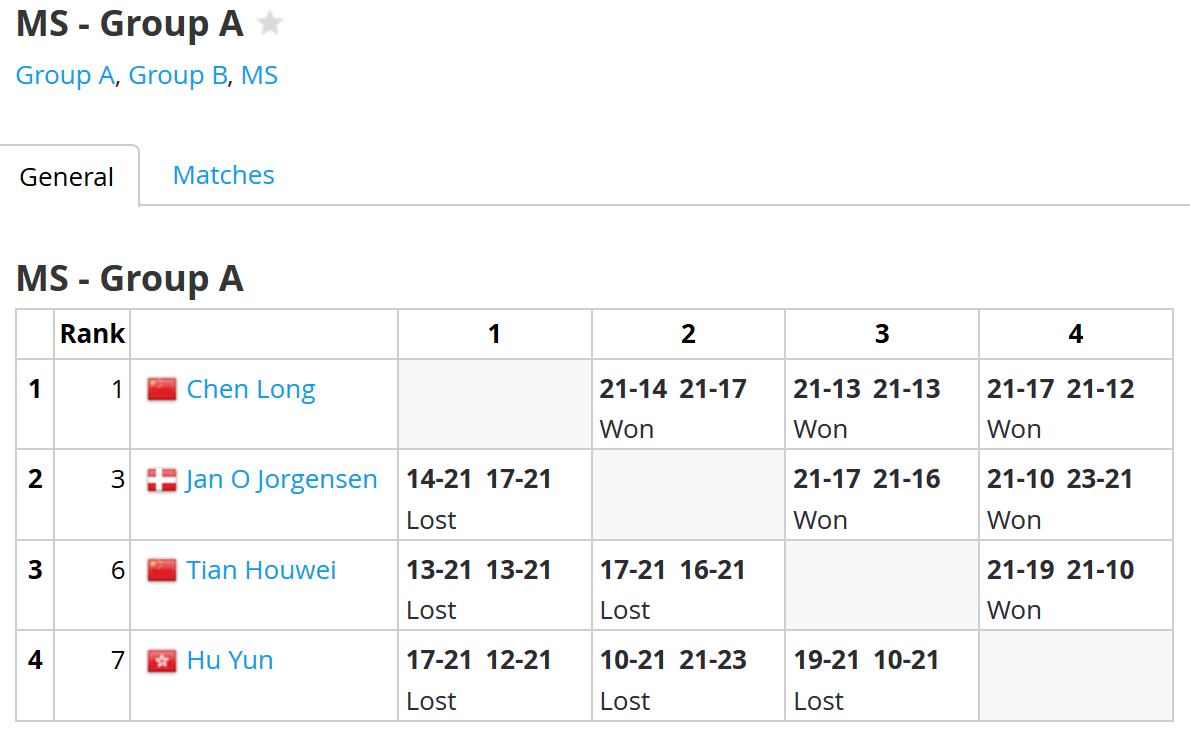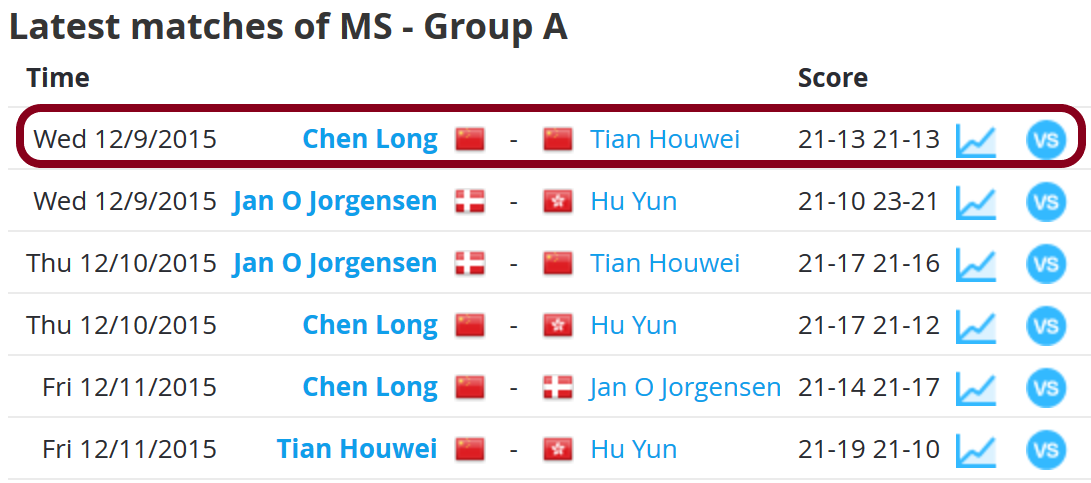Recommendations to Event Organizers
This section will mainly serve the Event Organizers who conduct Badminton Events in the UAE on a regular basis. UAE Badminton will add information relevant to them on a timely basis. Feel free to make use of the information and guidelines available on this page.
We have uploaded some templates that could be useful to Event Organizers. You may download them from the links below. These templates are helpful for academies/schools or clubs who require to do a bulk entry of players for tournaments. Proper usage of these templates allows the seamless import of entries to Badminton Tournament Planner. Feel Free to make use of them.
Copyright © UAE Badminton Federation 2022.Unauthorized copying of contents prohibited. Page last updated: 15/08/202, 17:00hrs.
UAE Badminton Junior Championship Group Player Entry Template 2023 (ver. 1.1)
UAE Badminton Senior Players' Group Entry Template 2023 (ver. 1.1)
Ranking in Group Play
Many of our local tournaments use the “Round Robin Qualification with Elimination” system, which uses “Group Play” in the initial rounds and then proceeds to elimination rounds. We understand that the organizers and players prefer this format for the various reasons, including;
- Players/pairs get more chances to play.
- Creating more winning moments and thereby encouraging healthy competition amongst the local community.
However, we have observed that several organizers have difficulty in implementing the regulations while finding the right qualifiers after completing the group play. We intend to clarify some of their doubts by using real-life examples and the BWF General Competition Regulations.
Ranking Basics
The most important parameter that establishes Ranking in Individual Tournaments is the “number of matches won” by a player/pair during the Group play. If two players/pairs have won the same number of matches, the “winner of the match between them” will be ranked higher.
There is no need to look at the other variables like “difference between total games won and total games lost” or “difference between total points won and total points lost” unless three or more players/pairs have won the same number of matches.
The Tournament Planner (BTP) shows the right qualifier automatically, once the Group Play has finished and the scores are correctly inserted. However, the right technical information must be understood well, to handle challenging situations that may arise during a practical tournament scenario.
Let’s look at a couple of real scenarios first. [Note: You can click or hover the mouse over the numbered list to expand the view]
The following is a real example of “Triple Tie” of “Matches won” in a Group of Four players within Group E of Girls Singles Under 14 during a Schools Tournament (scoring system 3x11(12))
Picture 1.
In Group E (GS U14) with four players, three players (Selima, Arwa, and Shouq) are “Tied” with the same number of “Matches” won. See the blue outline (1) in the above picture.
Let’s see how we can establish a clear ranking here, in the next section.
BWF GCR (General Competition Regulations) carry detailed instructions on how to handle Ranking in Group Play. GCR subsection 16.2 covers individual events, whereas 16.3 is about team events. We are discussing about Individual Events in this article. Refer to the screenshot (Picture 2) of the relevant page from GCR.
Picture 2.
We encourage you to download the GCR from BWF Statutes website and read it completely.
Applying GCR 16.2.3 to the above example, the difference between “total games won” and “total games lost” are calculated, and the Player/pair with the “greater difference” will be ranked higher.
Picture 3.
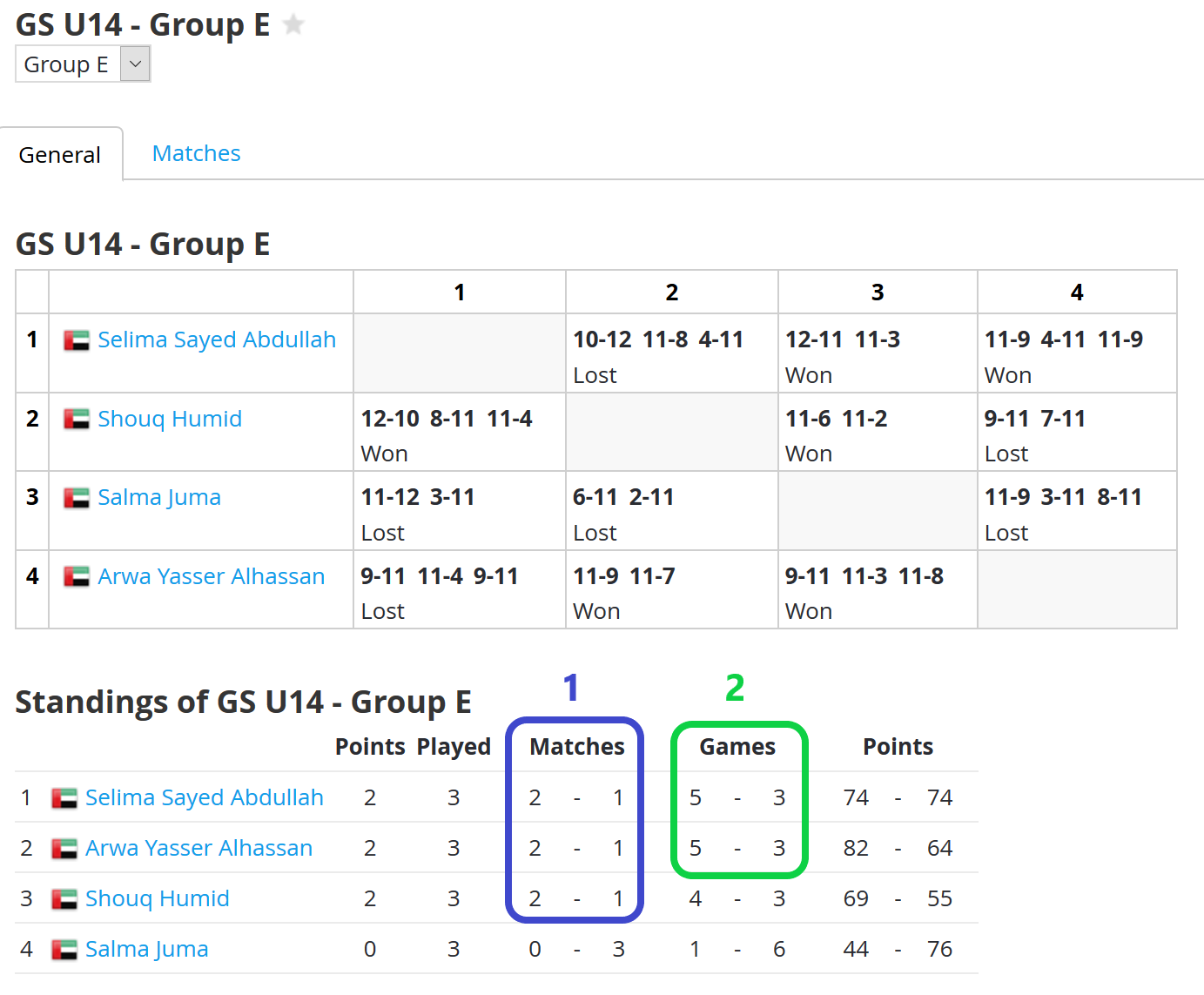
In our example, the first two players (Selima and Arwa) are tied again with 5-3 win-loss of total games. See the green outline (2) in the above picture. The third player (Shouq) is out of the tie scenario now, as her win-loss is 4-3.
Now, we need to resolve the tie between the first two players.
Let’s move on to GCR 16.2.3.1 to resolve the two-way tie in terms of total games won/lost. If two Players/pairs are still equal after calculating the difference between total games won and total games lost, the winner of the match between them will be ranked higher.
To apply this in our scenario, we need to find the match between the players highlighted in green outline and the winner of that encounter will be ranked higher. Refer to the screenshot below (Picture 4), which shows the subject match.
Picture 4.
As seen above from the match highlighted in orange, it was Player 1 (Selima) who won the match against the Player 2 (Arwa) in their encounter during the group play and hence she is ranked higher. Hence, in this tournament, Selima is selected as the Qualifier from Group E, for Quarter Finals.
By applying the GCR 16.2 systematically, we have established the ranking in this group without any ambiguity.
Having understood the regular occurrences of a “tie” regarding “Matches won,” let's look at some complicated scenarios, purely for learning.
If the three players in the example cited above, were in a tie of “Matches won” and the “difference between total games won and total games lost,” then we need to apply GCR 16.2.4, wherein the “difference between total points won and total points lost” are calculated, with the greater difference ranked higher.
Let’s look at the simulation in 2.1 below to understand.
The below scenario is created for learning the usage of "the difference between Total Points won and Total Points lost" as per GCR 16.2.4 to resolve a tie situation.
In the simulated group standings table above, the Player 1 will be ranked higher, as he/she has the greater difference between total points won and total points lost.
In case the two players had the same number as the difference between total points won and total points lost, we would have to enforce 16.2.4.1, and a ranking must be established by finding the winner of the match between them.
Team Championships: In the case of Team Tournaments, the same logic is applicable, but the GCR reference is 16.3. You can find an example from the UAE National League - Yonex Shuttle Time Dubai Club Championship 2022 Level C Group Play below
The link to the Tournament Software page showing the Group Stage results is from here.
As you can see from above, the three teams have an equal number of “difference between total ties won and total ties lost” as in GCR 16.3.3, equal in the “difference between total matches won and total matches lost as in GCR 16.3.4 and are also equal in the “difference between total games won and total games lost” as in GCR 16.3.5.
Hence, the following option to find the winner is to go ahead with the difference between total points won and total points lost, with a greater difference ranked higher, as outlined in GCR 16.3.6
We can see that difference in the total points won and total points lost are +8, -2, and -6, respectively, giving us a clear ranking in the group.
Another scenario is created for for learning the procedure when a triple tie of “difference between total points won- total points lost" occurs, as per GCR 16.2.4.2. It is technically possible that three or more Players/pairs may have a tie regarding the difference between total points won and total points lost.
As in the simulated group standings table above, Players 1-3 are “tied” by all variables that we could apply. If such a situation ever occurs, then a “draw of lots” must be done to establish the ranking, as there is nothing that separates these teams in terms of strength.
See our recommendation on “Drawing of lots” in section 4.3
We have seen many organizers opting for a single game of 21 points (deuce up to 30) or a single game of 30 points during Group play, to save time. Nevertheless, this format increases chances of a “tie” during group play, as one of the variables (number of games being constant per match) is eliminated. Find our comments regarding this format and some alternatives as well in section 4.1 of this document.
Let’s look at a couple of tie scenarios in a Single Game Group Play.
The real example given below is from the Group Play of MD Flight 2 - Group A at the BKS Syed Modi Badminton Tournament, April 2018 - Bahrain (used with permission)
Picture 5
As seen in Picture 5 above, three pairs have won the same number of matches, and the difference between total games won/lost. Moreover, the matches won/lost are the same as the total games won/lost in this example, due to the single-game format.
Hence, we must directly proceed to 16.2.4, to look at the difference between total points won, and total points lost to establish a ranking. After calculating the difference between total points won and total points lost, it is clear that the Pair 1 (Naushad KK & Leo Pulpally) is ranked higher, as their total points difference (14) is higher than that of the other two pairs (10 and 1 respectively). Hence, by applying GCR 16.2.4 directly, we have established the ranking.
Had there been a tie between two pairs again, regarding the difference between total points won and total points lost, we would have resorted to GCR 16.2.4.1 and find out the result of the match between them for a ranking.
If all the three pairs had the same difference in total points won and total points lost, we would rely on the “drawing of lots” as per section 2.2 of this document.
This example is also from the same tournament, but from the MD Flight 1 – Group A.
This is like the example in section 1.3; the only difference is that the number of matches and games won are identical.
Picture 6
As seen from Picture 6 above, two pairs (Dr. Bijosh Jose/ Ganesh Jeeva Nivas and Anuraj/ Yunus Nagathukandy) were “tied” with reference to Matches won, and the difference between total games won/lost. Hence, we must go to Step 1.3 above to rely on GCR 16.2.3.1 and look at the match involving the highlighted pairs (4).
Picture 7.
As per the match result highlighted above, it is the Pair 1 (Dr. Bijosh Jose/ Ganesh Jeeva Nivas) who won over the team 2 and hence, they are ranked higher.
In case of a two-way tie within a group, we must always establish a ranking by finding out the “winner of the match between them” as in GCR 16.2.3.1 or 16.2.4.1 as applicable.
A Few Recommendations to Organizers
There are several advantages of using multiple games in the Group Play. From a player perspective, they can have more opportunities to compete and a fair chance to come back after a slow start during the first game at the venue. From an organizer’s point of view, they have more transparent options in determining the group winners.
Having said that, it is worth mentioning some statistics from our records*.
*based on duration inputs in TP files submitted by organizers, non-validated data.
As the numbers speak for themselves, the 3x11 format can enhance competition while adding value to the tournament. Hence, even if time is a deciding factor, it is worth experimenting the 3x11 format, for all the right reasons.
Always keep the number of round robin groups in a balanced manner. For example, we recommend keeping the number of groups limited to 4, 8, 16, 32 and so on, as it gives the right number of qualifiers for the elimination rounds. If you happen to use an unbalanced number of groups like 7 or 6, you will have one or two vacant spots in the elimination draw respectively, once the group play has concluded. In this case, you must find the next “Best #2” and “Best #3” Players/pairs as applicable, across all groups to promote to this missing link. This scenario might lead to confusions and disputes, as there could be walkovers in one group and not in the other.
If you ever happen to have a situation depicted in 2.2 (drawing lots), transparently conduct the same in the presence of the affected Players/pairs. Wherever applicable, use a “double draw” method, which first draws the position and then draws the Player/pair to the respective position. There is no harm in doing a video record of the process, to avoid disputes at a later stage.
See the subsections 4.4.1 and 4.4.2
As you can see from the table above , the number of matches in a group increases exponentially based on the number of Players/pairs in a group, and it will have a drastic effect on the scheduling of the tournament.
We strongly recommend keeping the number of Players/pairs the same across all groups in one category. This will make the number of matches per Players/pairs uniform across groups and ensure fair play. It is a clever idea to maintain a reserve list of Players/pairs in order to promote them to the group play, once you come to know about any possible withdrawal from a group.
This must be done in fairness considering the strength of Players/pairs without affecting the seeding and as per the Withdrawals and Promotions guidelines in GCR 13.
As per the GCR, if there are Players/pairs from the same “member” (member association/country) in the same group, the match or matches between them must be completed first, irrespective of their order in the group. In a national scenario, the term “member” can be equated to a Club or an Academy in which the Player/pair belongs, as per their entry into the tournament.
Find an example below, from the Dubai World Super Series Finals 2015, MS – Group A
Picture 8
There were two players from China (Chen Long and Tian Houwei) in the MS - Group A. As you can see from the matches list given below (Picture 9), the match between Chen Long and Tian Houwei was scheduled first, applying the GCR 16.3.10 (opted 1 vs. 3, instead of the usual 1 vs. 4 as per GCR 16.3.9)
Picture 9
If a Player/pair is unable to complete all their matches in the group play stage for whatsoever reasons, all their results will be deleted. (GCR 16.2.5)
For example, in a group of Four, a Player/pair must play 3 matches. Consider that Player/pair A had played two matches and won both, leading the group. However, if they could not complete their third group match (e.g., due to injury), their results will be removed and ranking discarded.
If the withdrawal was due to an injury, they could not play any further matches, but they are entitled to receive prizes according to the results they have obtained before the withdrawal.
We would like to hear from you
Hope you have enjoyed the above scenarios and recommendations. Should you have any comments or suggestions on the above, feel free to write to us
Copyright © UAE Badminton Federation 2022.Unauthorized copying of contents prohibited. Page last updated: 15/08/2022, 17:00hrs.

